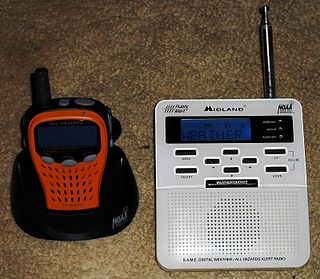
The Emergency Broadcast System (EBS), sometimes called the Emergency Broadcasting System or the Emergency Action Notification System (EANS), was an emergency warning system used in the United States. It replaced the previous CONELRAD system and was used from 1963 to 1997, at which point it was replaced by the Emergency Alert System.
SOS is a Morse code distress signal, used internationally, that was originally established for maritime use. In formal notation SOS is written with an overscore line, to indicate that the Morse code equivalents for the individual letters of "SOS" are transmitted as an unbroken sequence of three dots / three dashes / three dots, with no spaces between the letters. In International Morse Code three dots form the letter "S" and three dashes make the letter "O", so "S O S" became a common way to remember the order of the dots and dashes.

Medium frequency (MF) is the ITU designation for radio frequencies (RF) in the range of 300 kilohertz (kHz) to 3 megahertz (MHz). Part of this band is the medium wave (MW) AM broadcast band. The MF band is also known as the hectometer band as the wavelengths range from ten to one hectometer. Frequencies immediately below MF are denoted low frequency (LF), while the first band of higher frequencies is known as high frequency (HF). MF is mostly used for AM radio broadcasting, navigational radio beacons, maritime ship-to-shore communication, and transoceanic air traffic control.
Radio Data System (RDS) is a communications protocol standard for embedding small amounts of digital information in conventional FM radio broadcasts. RDS standardizes several types of information transmitted, including time, station identification and program information.
A subcarrier is a sideband of a radio frequency carrier wave, which is modulated to send additional information. Examples include the provision of colour in a black and white television system or the provision of stereo in a monophonic radio broadcast. There is no physical difference between a carrier and a subcarrier; the "sub" implies that it has been derived from a carrier, which has been amplitude modulated by a steady signal and has a constant frequency relation to it.

Digital Radio Mondiale is a set of digital audio broadcasting technologies designed to work over the bands currently used for analogue radio broadcasting including AM broadcasting, particularly shortwave, and FM broadcasting. DRM is more spectrally efficient than AM and FM, allowing more stations, at higher quality, into a given amount of bandwidth, using xHE-AAC audio coding format. Various other MPEG-4 and Opus codecs are also compatible, but the standard now specifies xHE-AAC.
Second audio program (SAP), also known as secondary audio programming, is an auxiliary audio channel for analog television that can be broadcast or transmitted both over-the-air and by cable television. Used mostly for audio description or other languages, SAP is part of the multichannel television sound (MTS) standard originally set by the National Television Systems Committee (NTSC) in 1984 in the United States. The NTSC video format and MTS are also used in Canada and Mexico.
Specific Area Message Encoding (SAME) is a protocol used for framing and classification of broadcast emergency warning messages. It was developed by the United States National Weather Service for use on its NOAA Weather Radio (NWR) network, and was later adopted by the Federal Communications Commission for the Emergency Alert System, then subsequently by Environment Canada for use on its Weatheradio Canada service. It is also used to set off receivers in Mexico City and surrounding areas as part of the Mexican Seismic Alert System (SASMEX).

NOAA Weather Radio is an automated 24-hour network of VHF FM weather radio stations in the United States (U.S.) that broadcast weather information directly from a nearby National Weather Service office. The routine programming cycle includes local or regional weather forecasts, synopsis, climate summaries or zone/lake/coastal waters forecasts. During severe conditions the cycle is shortened into: hazardous weather outlooks, short-term forecasts, special weather statements or tropical weather summaries. It occasionally broadcasts other non-weather related events such as national security statements, natural disaster information, environmental and public safety statements, civil emergencies, fires, evacuation orders, and other hazards sourced from the Federal Communications Commission's (FCC) Emergency Alert System. NOAA Weather Radio uses automated broadcast technology that allows for the recycling of segments featured in one broadcast cycle seamlessly into another and more regular updating of segments to each of the transmitters. It also speeds up the warning transmitting process.

A non-directional (radio) beacon (NDB) is a radio transmitter at a known location, used as an aviation or marine navigational aid. As the name implies, the signal transmitted does not include inherent directional information, in contrast to other navigational aids such as low frequency radio range, VHF omnidirectional range (VOR) and TACAN. NDB signals follow the curvature of the Earth, so they can be received at much greater distances at lower altitudes, a major advantage over VOR. However, NDB signals are also affected more by atmospheric conditions, mountainous terrain, coastal refraction and electrical storms, particularly at long range.

Travelers Information Stations (TIS), also called Highway Advisory Radio (HAR) by the United States Department of Transportation, are licensed low-powered non-commercial radio stations, used to broadcast information to the general public, including for motorists regarding travel, destinations of interest, and situations of imminent danger and emergencies. They are commonly operated by transportation departments, national and local parks departments and historic sites, airport authorities, local governments, federal agencies, colleges and universities, hospitals and health agencies, and for special events and destinations.

KNX is a commercial radio station in Los Angeles, California. It airs an all-news radio format and is owned by Audacy, Inc. KNX is one of the oldest stations in the United States, having received its first broadcasting license, as KGC, in December 1921, in addition to tracing its history to the September 1920 operations of an earlier amateur station. The studios and offices—shared with KNOU, KCBS-FM, KROQ-FM, KRTH and KTWV—are located on Los Angeles' Miracle Mile.

FM broadcasting is a method of radio broadcasting using frequency modulation (FM). Invented in 1933 by American engineer Edwin Armstrong, wide-band FM is used worldwide to provide high fidelity sound over broadcast radio. FM broadcasting is capable of higher fidelity—that is, more accurate reproduction of the original program sound—than other broadcasting technologies, such as AM broadcasting. Therefore, FM is used for most broadcasts of music or general audio. FM radio stations use the very high frequency range of radio frequencies.
WWL is a U.S. radio station in New Orleans, Louisiana, owned by Audacy, Inc. 870 is a clear channel frequency on which WWL reaches large parts of the Gulf Coast in the daytime, and much of the Central and Southern United States at night. It can be heard as far north as Minneapolis, MN under ideal broadcasting conditions at night. In April 2006, it began to simulcast on WWL-FM 105.3 MHz allowing the station's listeners to choose between AM and FM. The station has a talk radio format with sports talk at night. WWL is a long-time affiliate of the CBS Radio Network. The station's studios are located at the 400 Poydras Tower in the New Orleans Central Business District and the transmitter site is in Estelle, Louisiana.

WBAP is an AM news/talk radio station licensed to Fort Worth, Texas, and serving the Dallas-Fort Worth Metroplex. WBAP is owned by Cumulus Media and broadcasts with 50,000 watts from a transmitter site in the northwest corner of Mansfield. It is a Class A clear-channel station, using a non-directional antenna. Its nighttime signal can often be heard throughout the Southern, Central, and Midwestern states and Northern Mexico, while its daytime signal provides at least secondary coverage from Oklahoma City to Austin. The station's studios are located in the Victory Park district in Dallas just north of downtown. WBAP is one of the oldest radio stations in Texas, dating back to 1922, when stations in Texas were still given call signs beginning with "W" instead of "K."

A weather radio is a specialized radio receiver that is designed to receive a public broadcast service, typically from government-owned radio stations, dedicated to airing weather reports on a continual basis, with the routine weather reports being interrupted by emergency weather reports whenever needed. Weather radios are typically equipped with a standby alerting function—if the radio is muted or tuned to another band and a severe weather bulletin is transmitted, it can automatically sound an alarm and/or switch to a pre-tuned weather channel for emergency weather information.
KFQD is a commercial AM radio station in Anchorage, Alaska known as "News Talk 750 and 103.7 KFQD." It broadcasts a News/Talk radio format and is owned by Alpha Media LLC. The studios and offices are on Artic Slope Avenue in Anchorage.

WGU-20, also known as "the last radio station," was operated by the United States Defense Civil Preparedness Agency in the 1970s.

WKAQ is a radio station in San Juan, Puerto Rico that broadcasts on 580 kHz with a Spanish language talk radio format. The station is currently owned by Univision Radio. Its programming is repeated on WUKQ, which broadcasts on 1420 kHz in Ponce, and WYEL which broadcasts on 600 kHz in Mayagüez. The station was the first radio station to broadcast in Puerto Rico. According to Ernesto Vigoreaux, in the early days of music in Puerto Rico, the musicians would record music at the WKAQ radio station. WKAQ is the Puerto Rico primary entry point station for the Emergency Alert System.

KTWO is an American radio station licensed to Casper, Wyoming operating on 1030 kHz. KTWO broadcasts a 50,000 watt signal from a three-tower facility located east of Casper near Hat Six Road. The station features several talk shows such as Rush Limbaugh and Coast to Coast AM.












